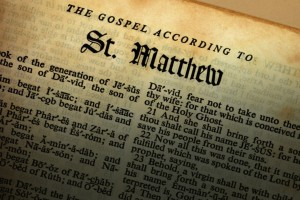 When skeptics challenge the reliability of the Gospels, they often point to apparent contradictions in the accounts to make their case. One example of this can be found by comparing the demoniacs of Gadara mentioned in Matthew 8:28-34 to the demoniac of Gerasa described in Mark 5:1-20. Both Mark and Matthew appear to be describing the same healing, yet there are two immediate differences in the accounts:
When skeptics challenge the reliability of the Gospels, they often point to apparent contradictions in the accounts to make their case. One example of this can be found by comparing the demoniacs of Gadara mentioned in Matthew 8:28-34 to the demoniac of Gerasa described in Mark 5:1-20. Both Mark and Matthew appear to be describing the same healing, yet there are two immediate differences in the accounts:
Matthew 8:28
When He came to the other side into the country of the Gadarenes, two men who were demon-possessed met Him as they were coming out of the tombs.
Mark 5:1-3
They came to the other side of the sea, into the country of the Gerasenes. When He got out of the boat, immediately a man from the tombs with an unclean spirit met Him, and he had his dwelling among the tombs.
Are the original accounts contradictory? One account has Jesus performing the miracle in Gadarenes, the other in Gerasenes. One account has Jesus healing two demon possessed men, the other only one. There appear to be two separate contradictions in the accounts, along with a number of other details that are unique to each Gospel narrative. Some of the unique features of each account can be easily attributed to the distinct nature of the eyewitnesses. In fact, many of the variations within the accounts are well within the range of differences I would expect from two eyewitnesses who are describing the same event (I’ve written about this on one chapter of my book). But there is still the issue of location and number of demoniacs that seem more difficult to reconcile. Passages such as these provide us with an opportunity to ask two important questions related to eyewitness accounts from the past.
Ask: “Why Does the Account Contain An Alteration?”
Cold-case investigations typically result in a number of reports recording aspects of the same event. These reports are often written over a period of years by different officers. In one of my cases, the original homicide occurred near a Robinson’s department store in our local mall. The initial reports all referred to the store correctly, but a supplemental report written several years after the murder identified the business as a Macy’s department store. While this may have seemed confusing and contradictory, I immediately understood the reason for the apparent contradiction. The Robinson’s store was replaced by Macy’s several years after the murder, and the second generation investigator inadvertently inserted the name of the business that existed in his day, rather than the name of the business that existed at the time of the murder. Luckily, I had many older reports that correctly listed the business, and the jury had no problem recognizing the reason for the variation.
In a similar way, the accounts of the demoniac(s) contain two different descriptions of the location: the country of the Gadarenes and the country of the Gerasenes. Most ancient manuscripts of the Gospel of Matthew contain the reference to “the country of the Gadarenes” and this location makes sense if Gadara was the capital city of the region in the time of Jesus’ ministry (making anyone who lives in the area a “Gadarene”). But why would a later scribe insert the “country of the Gerasenes” into the text? One reasonable explanation may simply be that a later scribe identified the same area near the shore of Gennesaret by referencing the name of a city (Gerasa) that had become more popularly identified with the region in his day (like replacing the Robinson’s with a Macy’s). While the best textual evidence supports the country of the Gadarenes, there is a reasonable explanation for later alterations.
Ask: “Why Does the Account Contain An Accentuation?”
The second aspect of apparent contradiction is the number of demoniacs mentioned by Mark and Matthew. While the variation here may seem irreconcilable, it is a common feature of my cold-case investigations. When I conduct witness interviews, I begin by allowing each witness to recall the event in his or her own words without any guidance from me as an interviewer. These initial unregulated statements invariably raise questions. A witness can be so singularly focused on one aspect of the crime that he or she will use hundreds of words to describe the detail while completely omitting other important features of the crime. When I, as the investigator, ask important “follow-up” questions, witnesses typically adjust their descriptive imbalances.
Mark appears to offer a similar imbalance in his description of the one demoniac he accentuates. While Mark’s versions of Gospel events are typically briefer than the other Gospel authors, this account is actually longer than Matthew’s. Like some of my murder witnesses, Mark is singularly focused on one aspect of the scene. While Matthew describes the two demoniacs more generally, Mark is focused on the one “no one was able to bind” or “subdue”. This particular demoniac was apparently the most verbal, providing details of his own possession, and he was later seen “sitting down, clothed and in his right mind.” Like the unregulated initial statements of some of my homicide witnesses, Mark is so singularly focused on one of the demoniacs that he used hundreds of words to describe the man while completely omitting other important features of the scene. If I had been the first century detective working this case, I would most certainly have asked “follow-up” questions to help Mark address the imbalance in his description of events, including additional information related to the second demoniac he chose to omit.
As a Christian, I recognize the difference between the original “autographs” of scripture and the transmitted “texts” we have today. The original writings were inspired by God and inerrant, and even though the copies we have today might contain a variation (like the difference between Gadarenes and Gerasenes), we have the ability, as good detectives, to accurately determine what the original eyewitnesses truthfully described.
J. Warner Wallace is a Cold-Case Detective, a Christian Case Maker, and the author of Cold-Case Christianity, Cold-Case Christianity for Kids, and God’s Crime Scene.
Comment or Subscribe to J. Warner’s Daily Email
Save




